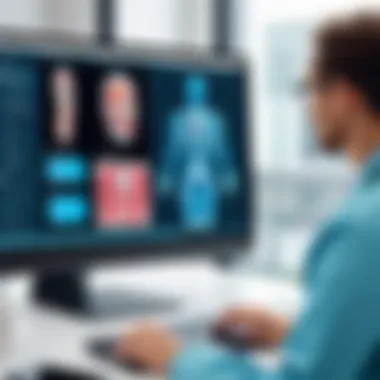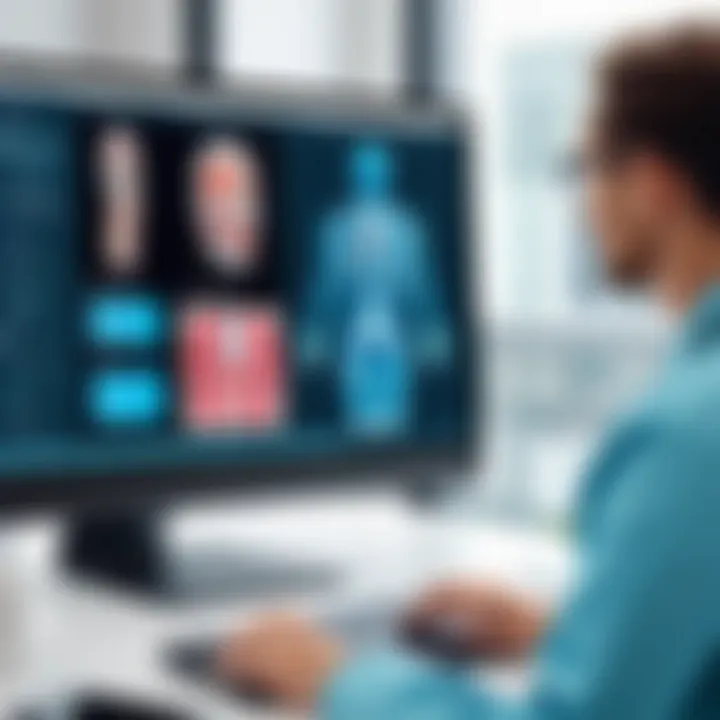Software Solutions Transforming Healthcare Delivery


Intro
In the rapidly-changing landscape of healthcare, software solutions have carved out a significant role, shaping how care is delivered and managed. From electronic health records to sophisticated telemedicine platforms, the digital transformation in this sector is hard to ignore. Medical professionals rely on these tools not only to streamline their operations but also to enhance the quality of the patient experience. Understanding the variety of software available is crucial for decision-makers and IT professionals who are tasked with implementing these technologies in clinical settings.
Software Category Overview
Definition and Importance
Healthcare software encompasses a broad range of applications designed to support the myriad of tasks that medical professionals engage in. This includes anything from administrative functions to direct patient care. The importance of these software solutions cannot be overstated; they help ensure that healthcare facilities function smoothly and efficiently while maintaining high standards of patient care.
One crucial aspect is the improvement of patient outcomes. Software solutions allow for better data management, more accurate diagnoses, and streamlined communication, which all contribute to enhanced patient experiences. In a sector where the stakes are so high, investing in the right software can be the difference between life and death, quite literally.
Key Characteristics
When assessing healthcare software, certain key characteristics often emerge. Consider the following points:
- User-Friendliness: Healthcare professionals often work under pressure, so software should be intuitive and easy to navigate.
- Interoperability: The ability for different systems to communicate with one another is crucial. This ensures comprehensive patient data management.
- Security and Compliance: Given the sensitivity of health information, software must adhere to stringent regulations like HIPAA, ensuring data security and patient privacy.
- Customization: Healthcare facilities differ in their operations. Having flexible software that can be tailored to specific needs is an invaluable advantage.
Comparative Analysis of Top Software Options
Feature Comparison
In examining the key software options available, it's essential to look at the features that set them apart. For instance, consider Electronic Health Records (EHR) systems like Epic and Cerner. Epic is known for its expansive functionalities, allowing for extensive patient data tracking, while Cerner offers real-time data analytics, which can improve clinical decision-making.
Key Features to Compare:
- Data Entry: Ease of entering patient data varies across platforms.
- Reporting Capabilities: The ability to generate reports for compliance or performance tracking.
- Patient Engagement Tools: Features that allow for better communication with patients, like portals or reminders.
Pricing Models
Understanding pricing models is also essential when evaluating software options. Generally, software in the healthcare sector operates on either a subscription-based model or a one-time purchase. For instance, some systems charge monthly fees based on the number of users or patients, while others require a substantial upfront payment with additional charges for ongoing support.
"Choosing the right software is not just a matter of features; it’s about understanding your specific needs and budget constraints."
Understanding the Role of Software in Healthcare
In today’s fast-paced world, software has become an integral part of the healthcare industry. The role of software in healthcare extends far beyond mere administrative functions; it touches every aspect of medical practice, from patient care to data management. The objective of this section is to grapple with how software tools enhance operational efficiency and improve patient outcomes while setting the stage for deeper exploration in subsequent sections.
Evaluating the importance of software in healthcare reveals several key elements. First and foremost, software aids in streamlining processes, enabling healthcare providers to focus on what they do best—caring for patients. By automating routine tasks such as appointment scheduling and billing, staff can redirect their efforts to patient engagement and clinical decision-making.
Another significant aspect lies in the ability to gather and analyze data. With the right software, practitioners can track patient histories and treatment outcomes effectively. This data-centric approach fosters a more informed healthcare environment, leading to evidence-based decisions that improve overall care standards.
Additionally, the relevance of patient/client interaction is amplified through software platforms. Communication tools offer secure channels for health-related queries, appointment reminders, and telehealth services. This not only enhances patient satisfaction but also ensures that health providers can deliver timely interventions.
"The innovations in healthcare software are not just changing how we practice medicine; they are fundamentally altering the patient experience."
Overall, the increasing complexity of patient needs and regulatory requirements necessitates robust software solutions that meet diverse demands. As we progress through this article, the evolution of healthcare software will be explored, emphasizing how various software types cater to the requirements of medical professionals and organizations alike.
The Evolution of Healthcare Software
The journey of software in healthcare isn’t a mere footnote in medical history; it’s a narrative rich with transformation. Starting as rudimentary systems that helped with basic administrative tasks, health software has evolved into comprehensive platforms that encompass clinical solutions and patient engagement.
In the early days, basic database systems were deployed, primarily for record-keeping. With time, these rudimentary systems faced limitations that prompted the development of more advanced solutions. The advent of Electronic Health Records (EHRs) marked a pivotal shift. These systems aggregated patient information and medical history into a unified digital format, ushering in an era where data could be accessed and shared seamlessly among medical professionals.
Recent advancements introduced artificial intelligence and machine learning into healthcare software. AI has enabled predictive analytics that assists in diagnosing conditions and suggesting treatment plans, effectively turning a space that was once reactive into a proactive environment.
Significance for Medical Professionals
The significance of software for medical professionals can hardly be overstated. From a practical viewpoint, software tools help reduce administrative burdens, allowing physicians to allocate more time to patient care. For nurses, physicians, and admin staff, software solutions facilitate a collaborative environment where patient care workflows are optimized.
Moreover, the integration of software enhances clinical decision-making. Clinical Decision Support Systems (CDSS) provide medical professionals with relevant patient data and evidence-based guidelines right at their fingertips. This continuous influx of information empowers providers to make informed choices, minimizing errors and improving outcomes.
Even beyond efficiency, the emotional aspect of care comes into play. When medical professionals spend less time on paperwork and more on engaging with patients or their families, it fosters a more compassionate healthcare setting. Therefore, software isn’t just a tool; it’s a catalyst for cultivating better relationships between providers and those they serve.
As we continue to explore various categories of healthcare software, these insights underscore the fundamental role that effective software solutions play in shaping the way medical professionals operate and deliver care.
Categories of Healthcare Software
In the array of modern healthcare, software operates like a heartbeat, pumping efficiency and reliability into systems that are crucial for patient care. Each category of software plays a unique role, addressing specific needs within healthcare facilities, and ultimately enhancing operational workflows. Understanding the distinct types of healthcare software can help medical professionals, administrators, and decision-makers align their technological investments with the demands of their patients and the efficiency of their practices.


Electronic Health Records (EHRs)
Electronic Health Records, or EHRs, are one of the cornerstones of modern healthcare software. These digital records are designed to collect and store comprehensive patient information, weaving together medical history, diagnoses, treatments, and a plethora of other healthcare data. The value of EHRs can’t be overstated; they facilitate quicker access to patient information, thus reducing time wasted in manual record-keeping.
Moreover, EHRs like Epic and Cerner not only enhance communication among healthcare providers but also contribute to more accurate diagnoses and treatment plans. Imagine a doctor accessing a patient's entire medical history with just a few clicks—gone are the days of rifling through thick paper files.
Practice Management Software
Next up, we have practice management software, which is tailored to assist with the day-to-day functions of running healthcare practices. This includes scheduling appointments, managing billing systems, and ensuring compliance with regulations. Programs like Athenahealth stand at the forefront, streamlining administrative tasks.
Why is this important? Reduced administrative workload allows healthcare personnel to focus more on patient care instead of drowning in paperwork. Besides, automating billing issues mitigates the risk of human error, ultimately resulting in a smoother operation.
Telemedicine Solutions
In an era marked by the digital revolution, telemedicine solutions have taken center stage, reshaping how healthcare is delivered. Services like Teladoc allow patients to consult healthcare professionals without setting foot in a clinic. This kind of accessibility not only broadens the reach of care but also caters to those who may have difficulty accessing in-person visits due to geographical or mobility constraints.
While the convenience is evident, it also promotes timely medical intervention, potentially reducing complications down the line. This evolution of care delivery emphasizes the idea that healthcare can—and should—be available at the fingertips of patients.
Medical Billing Software
Tied closely to the fiscal landscape of healthcare, medical billing software is vital for maintaining the financial health of medical practices. Ensure accurate claims submissions and manage payments seamlessly with applications like NextGen Healthcare. A notorious challenge in healthcare involves navigating the maze of insurance claims—this software tackles that head-on.
The advantages include quicker reimbursements and fewer discrepancies. Plus, it aids in compliance, ensuring practices adhere to regulatory standards—thus providing a more robust financial foundation.
Clinical Decision Support Systems
Clinical Decision Support Systems, or CDSS, equip healthcare providers with integrated data and knowledge to assist in clinical decision-making. By analyzing large volumes of data, these systems offer evidence-based recommendations tailored to individual patient needs.
For example, systems like UpToDate provide real-time guidelines and reminders at the point of care. Imagine a doctor faced with a tricky diagnosis—CDSS can suggest possible conditions based on symptoms, greatly enhancing the quality of care through informed decisions.
Patient Engagement Platforms
Finally, patient engagement platforms play an essential role in bridging the gap between providers and patients. These platforms, such as MyChart, empower patients by providing tools to manage their health actively. Patients can schedule appointments, access their health records, and communicate directly with their healthcare providers.
This level of engagement not only fosters a patient-centered approach but also encourages accountability in health management. After all, when patients feel in control of their care, they’re more likely to follow treatment recommendations.
“The future of healthcare is patient-driven, and technology is leading the charge.”
Understanding these categories of healthcare software lays the groundwork for an insightful analysis of how they contribute to improved outcomes, enhanced efficiency, and even financial stabilization for healthcare institutions. Each segment has its own unique set of tools and applications, collectively paving the way for a more efficient healthcare environment.
Popular Software Solutions in the Medical Field
In the rapidly changing landscape of healthcare, software solutions are more than just tools; they are lifelines that enhance the delivery of patient care, streamline operations, and promote the overall efficiency of health systems. Understanding popular software solutions in the medical field is essential for decision-makers and IT professionals as this knowledge forms the bedrock upon which healthcare advancements are built. Not only do these systems assist in maintaining patient records, but they also facilitate meaningful communication among care teams while easing administrative burdens. Consequently, keeping abreast of varied software options empowers medical institutions to make informed decisions about the technologies they adopt.
Overview of Leading EHR Systems
Electronic Health Records (EHR) systems stand as the backbone of digital healthcare management. Leading EHR systems, such as Epic and Cerner, offer comprehensive functionalities that encompass everything from documenting patient visits to managing billing processes.
The significance of these systems lies in their ability to centralize patient information. With well-integrated EHRs, healthcare providers have access to real-time data, which is crucial in treatment planning and decision-making. This instant access aids in reducing errors, improving diagnostics, and facilitating better patient outcomes.
Moreover, these systems often include interoperability features, which allow for seamless sharing of information with other systems. This, in turn, fosters a cohesive healthcare environment where various stakeholders are aligned on patient care initiatives. For example, the integration of lab results into EHRs means that doctors can swiftly view a patient's complete profile, ensuring no critical information slips through the cracks.
Notable Practice Management Software Options
Practice management software (PMS) serves to automate the administrative tasks that consume valuable hours in a provider’s day. Programs like Athenahealth and Allscripts streamline scheduling, billing, and patient communication.
By utilizing PMS, healthcare facilities can expect notable improvements in operational efficiency. For instance, automated appointment reminders reduce the number of missed appointments, ultimately optimizing the clinic's capacity. Furthermore, with accurate billing and coding features, these systems minimize the risk of revenue loss due to errors.
A paramount benefit is the analytic capabilities inherent in most PMS solutions. By evaluating appointment trends, patient demographics, and revenue cycles, practice managers can make data-driven decisions to enhance overall practice management.
Top Telemedicine Platforms
Telemedicine platforms like Teladoc and Doxy.me have gained prominence, especially following the COVID-19 pandemic, where remote consultations became a necessity. They provide a robust means of delivering real-time medical consultations and ongoing care management without the need for patients to physically visit medical facilities.
One of the key advantages of telemedicine is its ability to break down geographical barriers. Patients in remote areas or those with mobility challenges can receive care from specialists who are not accessible locally. This flexibility translates into improved patient satisfaction and compliance, as individuals are more likely to seek care without the transportation hurdles.
Additionally, the implementation of telehealth can lead to reduced hospital readmissions and higher adherence to follow-up appointments. In essence, these platforms represent a shift toward more inclusive and accessible healthcare for all.
"The digital evolution of healthcare is not a matter of choice; it is a necessity that plays a crucial role in influencing patient outcomes across the globe."


Features and Functionality of Medical Software
In today’s fast-paced healthcare landscape, the features and functionality of medical software are not merely useful; they’re essential. Software solutions serve as the backbone of healthcare systems, facilitating everything from patient record management to seamless communication among medical teams. The nuances of these tools can greatly influence the quality of patient care, and if chosen wisely, they can positively transform operational dynamics. Let’s delve into several pivotal aspects that demonstrate their significance in healthcare settings.
Interoperability Standards
Interoperability is a crucial aspect that ensures different healthcare systems and software can communicate with each other effectively. It dictates how information is shared across various platforms, which is increasingly important as more providers adopt specialized software solutions.
- Seamless Data Exchange: When medical software adheres to interoperability standards, data flows freely between systems such as Electronic Health Records (EHRs) and lab management programs. This unbroken chain of information mitigates the risk of errors and ensures healthcare providers have the most accurate patient data at their fingertips.
- Enhanced Care Coordination: With robust interoperability, healthcare teams can collaborate more effectively, ultimately leading to improved patient outcomes. For example, when a patient is referred from a primary care physician to a specialist, seamless information transfer ensures that no critical data is lost in transition.
- Regulatory Compliance: Various health regulations necessitate certain levels of interoperability. Software that meets these standards might be more favorable during audits or when seeking funding from government programs.
Achieving interoperability is no small feat, requiring careful selection of software solutions that prioritize this necessity.
Data Security and Compliance
In the realm of healthcare, data integrity can’t be compromised. With ever-growing cyber threats, the security features embedded in medical software play a fundamental role.
- Patient Privacy: Secure medical software prioritizes the confidentiality of patient information. This is vital not only for patient trust but also to adhere to regulations like the Health Insurance Portability and Accountability Act (HIPAA). Non-compliance can lead to hefty fines and reputational damage.
- Encryption Mechanisms: Effective software should employ encryption to protect data from unauthorized access, particularly in transit. Any leakage of sensitive information can have severe repercussions, making data security a non-negotiable attribute.
- Audit Trails: Robust software provides audit trails that help track access and modifications to patient records. This transparency is essential for maintaining accountability and can spell the difference in investigations of potential breaches.
With data breaches on the rise, the ability to ensure data security through software is critical for all healthcare providers.
User Experience and Interface Design
The user interface (UI) and overall experience of medical software are pivotal, especially considering that healthcare professionals often juggle multiple tasks at once.
- Intuitive Navigation: A well-designed interface minimizes the learning curve for new users. When software is intuitive, healthcare workers can spend less time fumbling around and more time focusing on patient care. An easy-to-navigate dashboard is a large plus.
- Responsive Design: Given the mobile nature of many healthcare settings, software should function well across different devices. A responsive design ensures that providers can easily access necessary systems whether they're at a desktop or a tablet on the go.
- Feedback Mechanisms: Incorporating user feedback into software design can greatly enhance functionality. Updates based on real-world usage ensure that the software evolves along with healthcare practices.
Ultimately, providing a user-friendly interface may empower healthcare professionals to work more effectively and efficiently, translating directly to enhanced patient satisfaction and outcomes.
Effective medical software is not just about what it does; it's how it integrates into everyday processes and ultimately affects patient care.
The Impact of Software on Patient Care
Software utilization within healthcare goes beyond mere operational efficiency; it plays a pivotal role in enhancing the quality of patient care. The integration of innovative software solutions has been transformative, influencing various facets of medical practice and patient interaction. In this section, we will delve into the significant benefits and implications of these software tools focusing on patient safety, workflow efficiency, and communication among healthcare teams.
Enhancing Patient Safety
When technology meets healthcare, the focus on patient safety cannot be overstated. Software systems, particularly Electronic Health Records (EHRs), minimize the risk of human error. By centralizing patient data, they provide health professionals with immediate access to crucial information, such as allergies or previous health issues. As a result, decisions can be made more swiftly and accurately. This is not just about convenience; it can be a matter of life and death.
- Standardized Protocols: Software can trigger reminders for drug interactions or necessary vaccinations, ensuring that healthcare providers adhere to standardized protocols, ultimately protecting patients.
- Real-Time Analytics: It allows for real-time monitoring of a patient’s condition. Alerts generated by monitoring systems can lead to timely interventions that could prevent complications.
"In healthcare, every second counts. Effective software solutions truly have the potential to be lifesavers."
Streamlining Clinical Workflows
The impact of healthcare software extends into the realm of clinical workflows, where time and efficiency are of the essence. By automating routine tasks, healthcare providers can redirect their focus toward patient interaction and care, improving overall service delivery.
- Automated Task Management: Routine administrative tasks, such as appointment scheduling and billing, can be managed through specialized software. This automation reduces the workload on healthcare staff, allowing them to devote more attention to patient care.
- Data Sharing Across Platforms: Interoperability of systems means that a patient’s data can be shared seamlessly among specialists, eliminating redundancy and the need for duplicate tests. This streamlined data flow ensures that everyone involved in a patient’s care is equipped with the essential information.
The cumulative effect of these efficiencies leads to a more patient-centered approach, where the healthcare staff is less bogged down by clerical duties and more available for direct interaction with patients.
Facilitating Communication in Healthcare Teams
Effective communication within healthcare teams is fundamental to patient care. Miscommunication can be detrimental, resulting in errors that might compromise patient safety. Healthcare software bridges these communication gaps, ensuring that every team member is on the same page.
- Collaboration Tools: Software solutions often come equipped with integrated communication platforms. These tools allow for instant messaging or video consultations between doctors, nurses, and other healthcare staff, fostering collaboration.
- Patient Access to Information: Software not only facilitates communication among professionals but also enhances how they engage patients. Platforms that allow patients to access their health information encourage them to take part in their own care, which has been shown to improve health outcomes.
Challenges in Implementing Healthcare Software
Implementing healthcare software presents a myriad of challenges that can significantly impact the success of medical facilities. As the healthcare landscape becomes increasingly dependent on technology, understanding these hurdles is crucial. This section will probe deep into three primary issues: cost considerations, training and adoption issues, and data migration challenges. Each of these aspects plays a vital role in the effective deployment and utilization of healthcare software.
Cost Considerations
Cost is one of the first things that comes to mind when discussing the implementation of any new software, especially in healthcare, where budgets are often tight. The initial outlay for licensing, hardware, and software setup can be daunting. However, that's just the tip of the iceberg. On-going expenses, including maintenance, support, and upgrades, can add up quickly, leading to financial strain if not carefully managed.
Moreover, practices must also consider the potential return on investment (ROI). For example, integrating Electronic Health Records (EHRs) can enhance operational efficiency, streamline patient care, and mitigate errors, which theoretically should translate into cost savings and improved patient outcomes. Yet, if the software falls short of expectations or fails to integrate smoothly into existing workflows, the anticipated benefits might never materialize.
To tackle cost-related issues, healthcare organizations should adopt a comprehensive budgeting strategy. It's advised to do a thorough analysis of different software solutions on the market, weighing their capabilities against their costs, to ensure a selected solution aligns with their financial framework and operational needs.
Training and Adoption Issues


Even the most advanced healthcare software won't be worth a dime without appropriate training and acceptance among staff. There's often a steep learning curve associated with new technology, and if medical professionals cannot adapt quickly, it can lead to frustration and decreased productivity.
Training is not a one-off effort; it needs to be continuous. Staff retention and turnover can add complexity, as newer employees require training just as seasoned personnel may need refreshers on upgraded systems. This learning process can divert attention from patient care, leading to a temporary dip in service quality.
A solution here might involve creating a formal training program that offers multiple sessions and resources such as FAQs, video tutorials, and dedicated support personnel. Having a champion within the practice can also help spark enthusiasm and motivate others to embrace the changes.
Data Migration Challenges
Data migration is perhaps one of the trickier aspects when implementing new software. Transferring existing patient records and clinical data to new systems often sounds easier than it is. It can be a painstaking process, fraught with risks of data loss or corruption if not executed meticulously.
A clear strategy for data migration should be established beforehand. This plan might include detailed mapping of the data to ensure precision, rigorous testing to catch and correct errors before going live, and a phased approach to allow for adjustments as problems arise. Additionally, involving staff in this process can help identify potential obstacles before they become issues.
"Success in implementing healthcare software lies not just in the technology itself, but in how people adapt and utilize it to enhance patient care."
This comprehensive look at the challenges provides insights and considerations that healthcare professionals must juggle to thrive in a tech-driven environment.
Future Trends in Healthcare Software
As we move further into the 21st century, the landscape of healthcare software is reshaping itself with an array of innovative trends. These advancements are no longer just enhancements; they are essential for keeping pace with patient needs and the demands of medical professionals. Addressing key future trends in healthcare software is crucial for decision-makers, IT professionals and entrepreneurs alike. Understanding what lies ahead allows stakeholders to adapt and thrive in a rapidly evolving environment.
A few critical elements stand out when considering the future: artificial intelligence integration, cloud-based solutions, and patient-centric innovations. Each of these trends presents unique benefits and considerations that can significantly influence how healthcare is delivered.
Artificial Intelligence Integration
Artificial intelligence (AI) isn’t just a buzzword; it’s becoming ingrained in healthcare software. The ability to process vast quantities of data allows AI to support clinicians in making better-informed decisions.
Benefits of AI integration include:
- Personalized medicine: Tailoring treatments based on a patient’s genetic makeup and lifestyle, potentially leading to better outcomes.
- Predictive analytics: Identifying health issues before they become severe by analyzing trends from historical data.
- Enhanced diagnostic tools: Algorithms that can assist in recognizing patterns and anomalies in imaging scans, which improves diagnostic accuracy.
Despite its advantages, AI implementation comes with its own challenges. There’s always the risk of over-reliance on technology, and issues with data privacy can arise as these systems require access to sensitive patient information. But if used correctly, AI solution can dramatically elevate the standard of care.
Cloud-Based Solutions
The shift to cloud-based infrastructure is gaining momentum, and healthcare is no exception. Cloud solutions offer scalability that traditional on-premise systems simply cannot match.
Some key advantages of embracing the cloud include:
- Improved accessibility: Providers can access patient information from anywhere, which is critical in emergencies when time is of the essence.
- Cost efficiency: Reduced costs for hardware and maintenance, freeing up financial resources to focus on patient care and technology upgrades.
- Enhanced collaboration: Healthcare teams can easily share information, aiding in comprehensive patient care.
Nonetheless, adopting cloud solutions necessitates a sound strategy. Concerns about data sovereignty and compliance with regulations such as HIPAA must be at the forefront of any planning.
Patient-Centric Innovations
Lastly, the drive towards patient-centric software is shaping how healthcare is structured. Patients increasingly demand involvement in their care, and software must evolve to address this.
This involves:
- User-friendly interfaces: Systems that prioritize ease of use ensure that patients can manage their information without frustration.
- Engaging mobile applications: These apps promote health literacy and allow patients to monitor their own health, fostering a proactive approach to wellness.
- Feedback loops: Systems that solicit patient input help practitioners tailor services to meet the unique needs of their populations.
While the focus on the patient is commendable, it requires a careful balance. The risk of information overload for patients is real, and therefore, software solutions must be designed to enhance, rather than complicate, the patient experience.
"The future of healthcare software hinges on the integration of technology and human experience."
In essence, the future trends in healthcare software are reshaping how clinicians interact with patients and manage vast amounts of data. Recognizing the importance of these trends can prepare healthcare organizations to adapt and thrive, ensuring they remain at the forefront of the industry.
Finale
In the rapidly evolving landscape of healthcare, the utilization of software is not just beneficial; it's essential for enhancing both patient care and operational excellence. This article highlights the multifaceted role of software in the medical field, emphasizing its significance in improving efficiency, boosting communication, and ultimately leading to better health outcomes.
Summarizing Key Insights
Throughout this exploration, several key insights emerge:
- Adaptability of Software Solutions: Healthcare software must evolve continuously, adapting to changing regulations and patient needs. Solutions that integrate seamlessly with existing workflows are particularly advantageous.
- Impact on Patient Engagement: Tools like patient engagement platforms have transformed the doctor-patient relationship. They empower patients with access to their own health data, enabling more informed decisions regarding their treatment. This paradigm shift is crucial for fostering collaboration in healthcare decisions.
- Interoperability and Data Sharing: The ability to share data across different software systems is paramount. Interoperable solutions not only streamline processes but also minimize the risks associated with data silos, enhancing overall patient safety.
- Security and Compliance: As healthcare increasingly relies on digital solutions, maintaining data security and compliance with regulations, such as HIPAA in the United States, becomes a major concern. Employing software that prioritizes robust security measures helps mitigate risks associated with data breaches.
"In the healthcare sector, the success of software solutions often hinges on their ability to integrate effectively while ensuring patient confidentiality."
The Importance of Continued Adaptation
The healthcare sector continues to face a myriad of challenges, from fluctuating technology standards to evolving patient expectations. Hence, the importance of continued adaptation cannot be overstated.
- Staying Ahead of Innovations: New technological advancements, such as artificial intelligence and machine learning, are reshaping how healthcare is delivered. Organizations that remain agile in incorporating these innovations can improve predictive analytics and enhance decision-making.
- Training and Development: Emphasizing ongoing education and training ensures that healthcare professionals are equipped to utilize these tools effectively. Investment in staff development goes hand in hand with the successful deployment of new solutions.
- Regulatory Changes: The healthcare regulations landscape is in constant flux. Therefore, healthcare providers must stay informed about regulatory updates to ensure compliance and exploit new opportunities that arise from these changes.
In summary, the journey towards achieving optimal healthcare software utilization is ongoing. It requires commitment and flexibility from all stakeholders involved. By embracing change and investing in the right tools and training, the healthcare sector can enhance both patient care and operational efficiency, ultimately leading to a more effective healthcare system.







